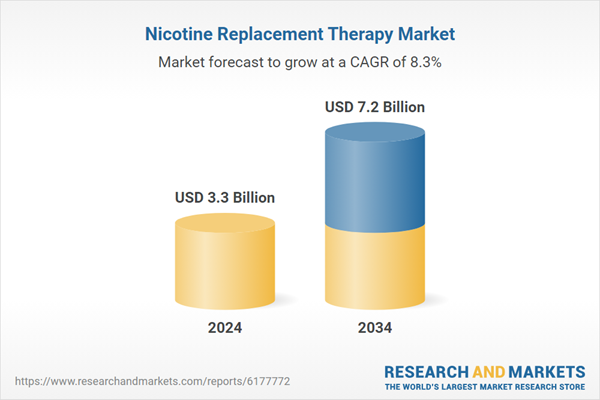The growth is driven by the increasing prevalence of smoking worldwide, stronger government regulations, tobacco control initiatives, and technological advancements in NRT products. The integration of digital health tools, including mobile applications, telemedicine, and AI-powered platforms, is enabling real-time monitoring of cravings and withdrawal symptoms. These innovations help improve treatment adherence and allow healthcare providers to tailor plans remotely, which is especially valuable in rural regions. The growing adoption of such technologies is further accelerating the market. Nicotine replacement therapy addresses the challenges smokers face when quitting, as abrupt cessation often causes intense cravings and withdrawal symptoms. Public health campaigns, taxation policies, and smoking bans are also propelling demand for NRT products. Additionally, new devices such as Bluetooth-enabled inhalers with feedback systems, fast-dissolving oral films, synthetic nicotine formulations, and AI-driven cessation apps are revolutionizing the market by enhancing bioavailability, user engagement, and treatment outcomes.
The gum segment held 49.6% share, and is anticipated to reach USD 3.5 billion by 2034, growing at an 8.2% CAGR. Nicotine gum remains a trusted and accessible option for managing withdrawal symptoms, making it highly favored by health-conscious consumers. As smoking is increasingly recognized as a chronic addiction, demand for long-term cessation aids like nicotine gum continues to rise. Healthcare professionals frequently recommend nicotine gum as part of comprehensive quitting plans due to its rapid absorption and effectiveness in easing withdrawal.
The oral segment generated USD 2.4 billion in 2024. This category includes lozenges, gums, and dissolvable films, which offer discreet and convenient solutions to control nicotine cravings. Their portability and non-invasive nature make them especially popular in public spaces such as workplaces and social environments. The convenience of these products enhances user compliance, particularly among younger and urban consumers who prefer subtle, on-demand options.
North America Nicotine Replacement Therapy Market held a 48.3% share in 2024. The region’s well-informed population is highly aware of the health dangers related to smoking, including cancer, heart disease, and respiratory issues. Ongoing public health efforts, educational programs, and media coverage have significantly influenced consumer behavior, driving demand for safer quitting methods like NRT. The high burden of tobacco-related diseases in North America strengthens the need for effective cessation solutions. Additionally, strict government policies, including advertising restrictions, elevated tobacco taxes, and public smoking bans, support market growth.
Key industry players active in the Global Nicotine Replacement Therapy Market include Glenmark, Johnson & Johnson, Cipla, Fertin Pharma, Dr. Reddy’s Laboratories, Pfizer, Rubicon Research, Sparsh Pharma, Niconovum, Pierre Fabre Group, Perrigo Company, Rusan Pharma, and GlaxoSmithKline. To fortify their presence, companies in the Nicotine Replacement Therapy Market are focusing on innovation by developing next-generation products that offer enhanced efficacy, improved user experience, and faster relief. Many are investing in digital health integrations such as mobile apps and AI tools to provide personalized treatment and remote monitoring, increasing patient adherence. Strategic collaborations with healthcare providers and pharmacies help broaden distribution channels. Marketing efforts highlight safety and convenience to appeal to a wider audience, including younger users and rural populations.
Comprehensive Market Analysis and Forecast
- Industry trends, key growth drivers, challenges, future opportunities, and regulatory landscape
- Competitive landscape with Porter’s Five Forces and PESTEL analysis
- Market size, segmentation, and regional forecasts
- In-depth company profiles, business strategies, financial insights, and SWOT analysis
This product will be delivered within 2-4 business days.
Table of Contents
Companies Mentioned
The companies profiled in this Nicotine Replacement Therapy market report include:- Cipla
- Dr. Reddy’s Laboratories
- Fertin Pharma
- Glenmark
- GlaxoSmithKline
- Johnson & Johnson
- Niconovum
- Pfizer
- Rubicon Research
- Rusan Pharma
- Sparsh Pharma
- Perrigo Company
- Pierre Fabre Group
Table Information
| Report Attribute | Details |
|---|---|
| No. of Pages | 140 |
| Published | September 2025 |
| Forecast Period | 2024 - 2034 |
| Estimated Market Value ( USD | $ 3.3 Billion |
| Forecasted Market Value ( USD | $ 7.2 Billion |
| Compound Annual Growth Rate | 8.3% |
| Regions Covered | Global |
| No. of Companies Mentioned | 14 |









